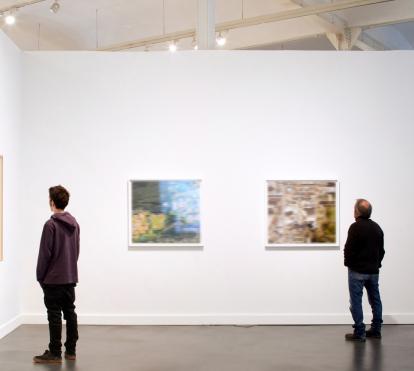
Exhibition: Engraving masters of the British Museum Collection (15th-20th c.)
16.09.03
5 minutes readPrinting with woodcuts was invented in 9th century China, and became established practice in Europe at the outset of the 15th. Artists such as Dürer, Rafael, Rubens, Rembrandt, Goya, Matisse and Picasso turned engravings into true works of art. To do so, they used techniques as complex as they were varied: mezzotint, xylography, burin engraving, etching, drypoint, aquatint, and others. But the invention of photography engendered certain confusion, to such extent that even today many believe that engraving is synonymous with simple reproduction. The exhibition Engraving masters of the British Museum Collection (15th-20th c.) not only shows that the pictures are veritable works of art, but features examples of the main techniques. The show, organised and produced by ”la Caixa” Foundation with material drawn from the immense British Museum collection, features 114 works that form a chronological overview of the past six centuries of art history: Hendrick Goltzius and Martin Schongauer's burin engravings; Albrecht Dürer and Ernst Ludwig Kirchner's xylographies; Rembrandt and Piranesi's etchings; the mezzotints of Ludwig von Siegen and John Martin; the lithographies of Goya, Manet and Käthe Kollwitz, to cite just a few.The exhibition Engraving masters of the British Museum Collection (15th-20th c.), curated by Mark McDonald, can be seen at the ”La Caixa” Foundation's Tarragona Social and Cultural Centre (Cristòfor Colom, 2), from 17 September, 2003 to 6 January, 2004.The British Museum's Collection of Prints and Drawings is among the most important in the world. It consists of over two million works on paper, spanning from the 15th century to the present day, including examples from all the main schools. Likewise, it features an impressive selection of ephemera (everyday papers, with short-term validity, such as bookmarks, leaflets, show programmes, posters, etc.). Among the most significant examples of this collection are the drawings and engravings of the great masters, satiric drawings of the 18th and 19th centuries and works done in Great Britain from all periods. Indeed, the exhibition Engraving masters of the British Museum Collection (15th-20th c.) invites visitors to view 114 works of major artistic worth and interest taken from this vast collection. Housed in the rooms of ”la Caixa” Foundation's Tarragona Social and Cultural Centre, the works constitute a route through six centuries of history marked by the names of engraving history's master engravers: Martin Schongauer, the Master of the Playing Cards (the first engraver whose name is known), Domenico Campagnola, Albrecht Dürer, Lucas Cranach the Elder, Federico Barocci, Anthony van Dyck, Peter Paul Rubens, Rembrandt, Giovanni Battista Piranesi, Francisco Goya y Lucientes, Théodore Géricault, Eugène Delacroix, Edouard Manet, Camille Pissarro, Edgar Degas, Henri de Toulouse-Lautrec, Edvard Munch, Emil Nolde, Ernst Ludwig Kirchner, Edward Hopper, Kurt Schwitters, Henri Matisse and Pablo Picasso, among many others.Engraving and its techniquesThe showing is more than a long inventory of illustrious names. It is an opportunity for visitors to unravel the many and complex printing techniques developed in Europe from the 15th century on. From relief techniques like xylography and linoleum engraving, woodblocks or metal, to the intaglio or chalcography techniques such as burin engraving and etching (the most commonplace within this category), drypoint, mezzotint and aquatint. Likewise, it offers several examples of work done with lithographic techniques. An engraving is essentially a picture made through a process that makes possible multiple reproductions. This procedure requires prior design and preparation of a printing surface. The design generally consists of a drawing, and the printing surface or plate tends to be wood, metal or stone. These surfaces are inked, and the image printed on a material such as paper. Before the invention of photomechanic reproduction methods, all engravings were produced or printed by hand. In fact, artists were all too aware that the number of prints their work could generate was limited by the wear of the plate. Today, "limited edition" engravings constitute a certain effort to counter the damaging implications of multiple reproduction to benefit a re-emergence of original engravings or, in other words, creation. "Original" and "reproduction" engravings are the two categories that a work of this genre may fall into. The former are those manually executed from designs cut by artists into wood blocks, metal plates or stones. Dürer, Rembrandt, Goya, Toulouse-Lautrec, Munch, Matisse and Picasso were among the many masters fascinated by original engravings. On another note, reproduction engravings have designs executed by a professional engraver who transfers an artist's work onto printing media. Some painters, such as Rafael, worked in close collaboration with engravers (in his case, Marcantonio Raimondi) for their work to be "translated" into etchings. Other similar examples are the engravings of John Smith, Wallerant Vaillant and William Pether, which all consist of reproductions of paintings.Processes and techniques vary widely. In embossing, the lines from which the printing is generated form a relief that stands out over the rest of the plate, which is lowered. The most common techniques are xylography (woodblocks) and linoleum or metal engraving. To the contrary, in intaglio or chalcography, the lines of the drawing are cut into the surface of a metal plate (usually copper, but iron and steel are also used). The plate is then inked and printed under great pressure, causing the paper to enter into the cut areas and absorb the ink. The two most common chalcographic techniques are burin engraving and etching. Lithography is based on the simple fact that oil and water are mutually repellent. This exhibition offers visitors examples of all of these techniques. Engraving masters of the British Museum Collection (15th-20th c.)From 17 September, 2003 to 6 January, 2004”la Caixa” Foundation Social and Cultural CentreCristòfor Colom, 243001 TarragonaTel.: 902 22 30 40Hours:Monday to Friday, 10 am to 2 pm and 5 to 9 pmSaturdays and Sundays, 11 am to 2 pm and 6 to 9 pmFree admissionwww.fundacio.lacaixa.es